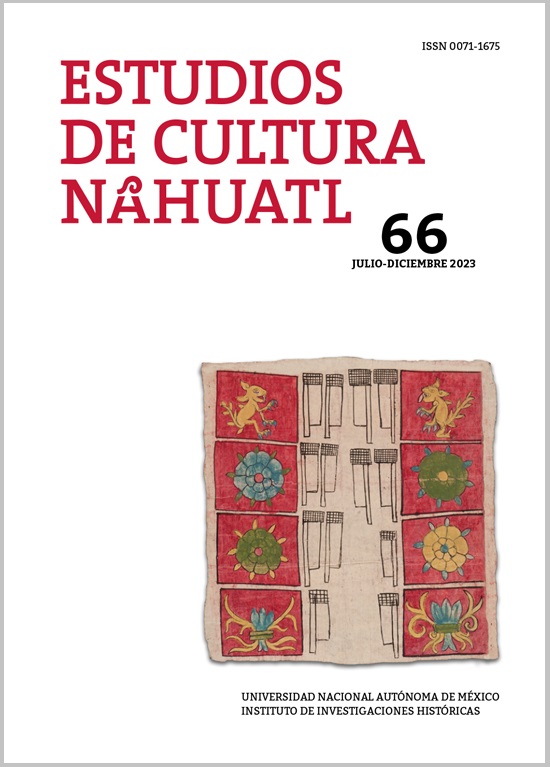Resumen
Las pinturas del Códice de Huexotzinco de 1531 se sometieron a un estudio técnico para arrojar luz sobre la fabricación y el uso de sus materiales por parte de artistas indígenas. Las técnicas no invasivas de examen macroscópico e imágenes multimodales permitieron una investigación profunda de los soportes de papel y las pinturas de los ocho cuadros del Códice y también mostraron las metodologías pictóricas y las preferencias materiales de los escribanos huexotzincas. El estudio también proporcionó información sobre la posible estandarización de los materiales de los artistas utilizados en la producción de códices de Mesoamérica.
Citas
- Albro, Sylvia Rodgers, and Thomas C. Albro. 1990. “The Examination and Conservation Treatment of the Library of Congress Harkness 1531 Huejotzingo Codex.” Journal of the American Institute for Conservation of Historic and Artistic Works 29 (2): 97–115.
- Albro, Sylvia Rodgers, and Thomas C. Albro. 1995. “The Examination and Conservation Treatment of the 1531 Huexotzinco Codex.” In Códice de Huexotzinco, 63–77 (in Spanish), 137–149 (in English). Mexico/Washington, D. C.: Coca Cola/Library of Congress.
- Berdan, Frances F. 2014. Aztec Archaeology and Ethnohistory. Cambridge: Cambridge University Press.
- Binnqüist, Citalli López, Alejandra Quintanar-Isaías, and Marie Vander Meeren. 2012. “Mexican Bark Paper: Evidence of History of Tree Species and Their Fiber Characteristics.” Economic Botany 66 (2): 138-148.
- Boone, Elizabeth Hill. 1998. “Pictorial Documents and Visual Thinking in Postconquest Mexico.” In Native Traditions in the Postconquest World, edited by Elizabeth Hill Boone and Tom Cummins, 149-193. Washington, D. C.: Dumbarton Oaks.
- Boone, Elizabeth Hill. 2000. Stories in Red and Black: Pictorial Histories of the Aztecs and Mixtecs. Austin: University of Texas Press.
- Buti, David, Davide Domenici, Costanza Miliani, Concepción García Sáiz, Teresa Gómez Espinoza, Félix Jímenez Villalba, Ana Verde Casanova, Ana Sabía de la Mata, Aldo Romani, Federica Presciutti, Brenda Doherty, Brunetto G. Brunetti, and Antonio Sgamellotti. 2014. “Non-Invasive Investigation of a Pre-Hispanic Maya Screenfold Book: The Madrid Codex.” Journal of Archaeological Science 42: 166-178.
- Buti, David, Davide Domenici, Chiara Grazia, Joanna Ostapkowicz, Siobhan Watts, Aldo Romani, Federica Presciutti, Brunetto Giovanni Brunetti, Antonio Sgamellotti, and Costanza Miliani. 2018. “Further Insight into the Mesoamerican Paint Technology: Unveiling the Colour Palette of Pre-Columbian Codex Fejérváry-Mayer by Means of Non-Invasive Analysis.” Archaeometry 60 (4): 797-814.
- Cortés, Hernán. 1843. The Despatches of Hernando Cortés: The Conqueror of Mexico, Addressed to the Emperor Charles V, Written during the Conquest, and Containing a Narrative of Its Events. Translated with an introduction and notes by George Folsom. New York: Wiley and Putnam.
- Cummins, Tom. 1995. “The Madonna and the Horse: Becoming Colonial in New Spain and Peru.” Phoebus: A Journal of Art History. Native Artists and Patrons in Colonial Latin America 7: 52-83.
- Díaz del Castillo, Bernal. 1963. The Conquest of New Spain. New York: Penguin. Digital Imaging Workflow for Treatment Documentation - Resources (Preservation, Library of Congress). [cited 2020 May 4]. Available from: https://www.loc.gov/preservation/resources/ImageDoc/index.html
- Domenici, Davide, David Buti, Constanza Miliani, Brunetto Giovanni Brunetti, and Antonio Sgamellotti. 2014. “The Colors of Indigenous Memory: Non-Invasive Analyses of Pre-Hispanic Mesoamerican Codices.” In Science and Art: The Painted Surface, edited by Antonio Sgamellotti, Brunetto Giovanni Brunetti, and Constanza Miliani, 94-119. Cambridge: Royal Society of Chemistry.
- Domenici, Davide, Constanza Miliani, David Buti, Brunetto Giovanni Brunetti, and Antonio Sgamellotti. 2018. “Coloring Materials, Technological Practices, and Painting Traditions: Cultural and Historical Implications of Nondestructive Chemical Analyses of Pre-Hispanic Mesoamerican Codices.” In Painting the Skin: Studies on the Pigments Applied on Bodies and Codices in Pre-Columbian Mesoamerica, edited by Élodie Dupey García and María Luisa Vázquez de Ágredos Pascual,129-143. Tucson: University of Arizona Press.
- Domenici, Davide, Constanza Miliani, and Antonio Sgamellotti. 2019. “Cultural and Historical Implications of Non-Destructive Analyses on Mesoamerican Codices in the Bodleian Libraries.” In Mesoamerican Manuscripts: New Scientific Approaches and Interpretations, edited by Maarten Jansen, Virginia M. Lladó-Buisán, and Ludo Snijders, 160-174. Leiden: Brill.
- Dyer, Joanne, Verri Giovanni, and John Cupitt. 2013. Multispectral Imaging in Reflectance and Photo-induced Luminescence modes: A User Manual. London: The British Museum.
- Havermans John, Habdell Abdul Aziz, and Hans Scholten. 2003. “Non Destructive Detection of Iron-Gall inks by Means of Multispectral Imaging, Part 2: Application on Original Objects Affected with Iron-Gall Ink Corrosion.” Restaurator 24 (2): 88–94.
- Hernández, Francisco. 1942. Historia de las plantas de la Nueva España. Mexico: Universidad Nacional Autónoma de México, Instituto de Biología.
- Lenz, Hans. 1961. Mexican Indian Paper: Its History and Survival. Mexico: Editorial Libros de Mexico.
- Library of Congress. 1974. The Harkness Collection in the Library of Congress; Manuscripts concerning Mexico: A Guide. Washington, D. C.: Library of Congress.
- Magaloni Kerpel, Diana. 2012. “The Traces of the Creative Process: Pictorial Materials and Techniques in the Beinecke Map.” In Painting a Map of Sixteenth-Century Mexico City: Land, Writing, and Native Rule, edited by Mary Ellen Miller and Barbara E. Mundy, 75-90. New Haven: Yale University Press.
- Magaloni Kerpel, Diana. 2014. The Colors of the New World: Artists, Materials, and the Creation of the Florentine Codex. Los Angeles: Getty Research Institute.
- Noguez, Xavier. 1995. “The Huexotzinco Codex.” In Códice de Huexotzinco, 17-62 (in Spanish), 91-136 (in English). México: Coca-Cola; Washington, D. C.: Library of Congress.
- Pottier, Fabien, Anne Michelin, Anne Genachte-Le Bail, Aurélie Tournié, Christine Andraud, Fabrice Goubard, Aymeric Histace, and Bertrand Lavédrine. 2018. “Preliminary Investigation on the Codex Borbonicus: Macroscopic Examination and Coloring Materials Characterization.” In Painting the Skin: Studies on the Pigments Applied on Bodies and Codices in Pre-Columbian Mesoamerica, edited by Élodie Dupey García and María Luisa Vázquez de Ágredos Pascual, 157-174. Tucson: University of Arizona Press.
- Sahagún, Bernardino de. 1981. Florentine Codex: General History of the Things of New Spain: Book 11 – Earthly Things. Edited by Charles E. Dibble and Arthur J. O. Anderson. Salt Lake City: The University of Utah Press.
- Tirado, Carolusa González, and Gabriela Cruz Chagoyán. 2013. “El Papel Maguey como Soporte Documental: Estudio de un Códice Huexotzinca del Período Colonial.” Conserva. Revista de Conservación, Restauración y Patromonio 18: 5-9.
- Vander Meeren, Marie. 1995. “El Papel Amate: Tecnololgía, Composición y Alteraciones.” Imprimatura 9: 3-9.
- Vander Meeren, Marie. 1997. “El Papel Amate: Origen y Supervivencia.” Arqueología Mexicana 4 (23): 70-73.
- Villafana, Tana Elizabeth, and Gwenanne Edwards. 2019. “Creation and Reference Characterization of Edo Period Japanese Woodblock Printing Ink Colorant Samples using Multimodal Imaging and Reflectance Spectroscopy.” Heritage Science 7 :94.
- Villafana, Tana Elizabeth, Mary Elizabeth Haude, and Amanda Sartorius. 2021. “An Analytical Study of the Huexotzinco Codex using X-ray Fluorescence, Fiber Optic Reflectance Spectroscopy, and Portable Fourier-transform Infrared Spectroscopy.” Heritage Science 9: 54.
- Von Hagen, Victor Wolfgang. 1977. The Aztec and Maya Papermakers. New York: Hacker Art Books.
- Warda, Jeffrey (editor), Franziska Frey, Dawn Heller, Dan Kuschel, Timothy Vitale, and Gawain Weaver. 2011. The AIC Guide to Digital Photography and Conservation Documentation, Second Edition. Washington, D. C.: American Institute for Conservation.
- Wiedemann, Hans G. 1995. “Paper Investigations of Maya and Aztec Cultures.” In Materials Issues in Art and Archaeology IV, Materials Research Society Symposium Proceedings Volume 352, edited by Pamela B. Vandiver et al., 711-722. Pittsburg, PA: Materials Research Society.
- Zetina, Sandra, José Luis Ruvalcaba, Tatiana Falcón, Jesús Arenas Alatorre, Saeko Yanagisawa, Marisa Álvarez Icaza Longoria, and Eumelia Hernández. 2014. “Material Study of the Codex Colombino.” In Science and Art: The Painted Surface, edited by Antonio Sgamellotti, Brunetto Giovanni Brunetti and Costanza Miliani, 120-146. Cambridge: Royal Society of Chemistry.
Cómo citar
Licencia
Derechos de autor 2023 Estudios de Cultura Náhuatl

Esta obra está bajo una licencia internacional Creative Commons Atribución-NoComercial-SinDerivadas 4.0.
- Resumen visto - 758 veces
- PDF (English) descargado - 390 veces


 Estudios de Cultura Náhuatl se encuentra bajo una
Estudios de Cultura Náhuatl se encuentra bajo una 








